 |
||
|
||
| ||
The last month was the first after the CeBiT exhibition and various new developments were being released as from the horn of plenty. In this brief excursion into a world of novelties I shall try to acquaint you with the most interesting of them. Mail your remarks, questions and comments to eldar@ixbt.com Market noveltiesAs it was already told, the announcements of new devices continued to arrive after the CeBIT. For example, ceramics electronic properties learning group in the Philips laboratory in Aachen, Germany has announced its development of the smallest mobile antenna in the world. Philips mini antennas are approximately 8 times smaller than usual at comparable metrics of efficiency. Now many telephone manufacturers use the combination of plastic and metal as the material for antennas in the case of the mobile telephone, however this requires the development of a new construction for each new telephone series and sufficient place for antenna in the construction. The advanced Philips design allows to reduce this size by 8 times. The standardized design makes it possible to allocate the antenna on top of any mobile telephone. Little is known about the design of antenna, it is only possible to assume the application of cermet in it. Philips supposes that the new item will be in demand for the mobile telephone manufacturers and manufacturers of radio units used for cordless data transfers between mobile telephones and computers, and between different computers in local area networks as well. Erkii Tiittanen, the director of platform creation department for Nokia Japan's mobile terminals, has presented the requirements for future displays of mobile gadgets. In his lecture about 3G terminals for mobile multimedia resources he has defined necessary parameters for three types of displays: for so-called 'image phone' and 'media phone' for the private users and also for business communicators. the image phone screen diagonal should be 5cm with 20000 pixels resolution; the media phone screen should be 8-10cm and 150000-200000 pixel resolution is required, and 10-cm display with 200000 pixel resolution is necessary for communicator. The manufacturers have partially foreseen these requirements and have made their own announcements. At the last CeBIT 2001 exhibition Samsung Electronics Co., Ltd. has presented display panels for mobile telephones with usage of OEL (organic electroluminescence) technology. The panel has resolution of 132 x 162 pixels, outer size of 42 x 52,8 mm, active zone size of 34,8 x 44 mm, more than 100:1 range of contrast, more than 170 degrees viewing angle, 1 microsecond response time, 100 mW power consumption. The company has already begun repetition work on such panels and plans to produce 20-30 thousand displays per month by June. Samsung negotiates about sales of new items with mobile telephone manufacturers only, though OEL-panels can be used in other areas as well (PDA, videocameras, automobile audio systems). By 2002 the company intends to begin production of greater sized panels, and by 2003 - to begin releases of active matrix displays. Mitsubishi has developed the technology which allows to put DRAM directly on a slice of polysilicone LCD display. As a result each pixel can be a 4-bit storage location, so it is possible to store 65K color images. The prototypes of new displays were shown at the EDEX (Electronic Display Exhibition) exhibition in Tokyo. 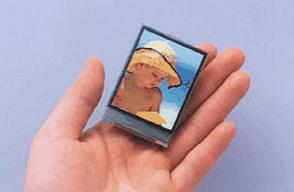 According to Mitsubishi representatives, such displays will help to save memory size in mobile devices and to reduce their energy consumption. The technologies of LCD displays with built-in memory were already developed by other companies (Toshiba), but they are based on SRAM and can store only 1 bit/pixel. Besides, the display with built-in DRAM needs as much place as usual display, while the SRAM-based technology doesn't have this advantage. And, in the end, eMagin company has announced the release of the first fully colored OLED mobile telephone display capable of imaging 16 millions of colors. The OLED technology can considerably reduce the cost of screens for all sorts of devices from cellular telephones and PDA to television screens and desktop computers. New eMagin display contains more than 1,5 million of individually addressed picture components. The main advantages of new displays, according to eMagin, are low power consumption, small weight, simple integration with optical resources, and the possibility of allocation directly on the processor. The screen has 0,62" diagonal and 600 x 800 pixel resolution for the analogue out jack of portable computers, or 852 x 480 pixel resolution for 16:9 wide-screen format for DVD players.  Right after these announcements LG Electronics has announced that it has completed the development of the new telephone with a large color LCD-screen intended for operation with Cdma2000-1x services. The telephone has 12-line color graphics display. Cyon Color Folder (as this handset is named now) can transmit the information via cdma2000-1x at the speed of 144 Kbps. Sprint PCS and Sanyo Fisher Company have announced the release of the new SCP-5000 mobile telephone. A remarkable feature of the given model is the two-inch liquid crystal display with 256 colors support. Internet access is granted by SprintPCS services. The telephone is already being sold in USA shops under the price of 499 dollars. Another advantage of the given telephone is the possibility of loading up to 20 photos, which can be used in a notepad, for example. As a result you will visually recognize the caller. The telephone is also capable of working in the answering device mode. Lithium battery allows the device to operate in idle mode up to 120 hours. Now it's cool to equip cellular telephones with image operation features. Sarnoff Corp. on the Society of Photo-optical and Instrumentation Engineers Aerosense Conference in April has presented the new development - a miniature BLINC digital camera for mobile telephones, automobiles, or safety systems. Unlike other similar items the camera provides the film-quality transmission of photo and video images along with the voice messages. The engineers have achieved impressive results: despite its small size, the camera's characteristics exceed some of similar devices of the greater size. The developers consider that their item will find wide application in safety systems, especially in the "intelligent" safety systems of automobiles, where it is possible to install up to 10 cameras inside passenger compartment for observation and control of the safety bag system. According to the American laws all automobiles should be equipped with similar systems after 2005. Wacom has informed of the development of new devices for text entering and drawing. They are so small that can be integrated in mobile devices like cellular telephones, PDA etc. 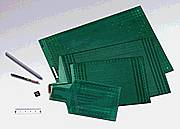 New miniature "stilos" from Wacom have diameter of 5,5 mm, that is same as for the majority delivered on the PDA market. Maximum point coordinate definition error is less than 0,4mm, input accuracy is up to 0,05 mm. Wacom has also developed the special controller for this device that allows to reduce final device cost by 60% in comparison with the previous samples, and also to essentially reduce energy consumption. The new package can work under many mobile and desktop operating systems (Windows 98, Me, 2000, CE, Linux, EPOC). The input technology is based on the effect of electromagnetic induction. Shippings will begin in June, and the project commercialization will take place in the autumn. 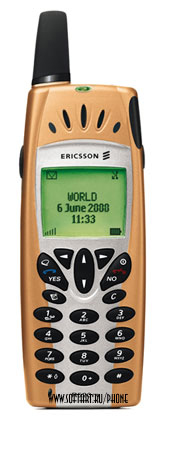 Another long-term commercial from the Ericsson company, namely R520m cellular phone, has appeared for sale at last. I shall remind, that R520m supports WAP along with HSCSD protocol, which increases transfer rate in GSM-networks. This telephone will become the platform for Bluetooth tests. The versions of the device with built-in support of this technology already exist, and Ericsson will begin testing Bluetooth in May. But those handsets, which are shipped now, do not support this cordless technology. In the same time it is planned to test R520m in the mobile payment system in the Swedish shops. Some users of the Eurocard payment system can take the advantage of the telephone as a virtual card for payments. The Bluetooth technology enables data communications across small distances that allows to use it in e-payment and m-commerce systems. Thus the procedure of payment for goods becomes twice simpler. The buyer just types a pin-code and the identification takes place automatically. But not everything is OK with this model, as it would be desirable for the manufacturer company. All handsets, sold during the first week, are subject of exchange due to banal energy consumption fault. For some unclear reason capacious batteries discharge very fast. It is good that the out-of-order handsets had no to leave Sweden in large quantities. And it seems to be a software error: the problem is solved by a simple patch. The Ericsson authorities have informed that the company will try to repair telephones and to them return to holders as soon as possible. Such haste is explained by the fact that R520m is strategically important device for Ericsson in the European market, where GPRS-networks operate already. 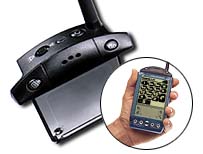 HandSpring company has made the long-awaited announcement about the beginning of retail sales in the USA of the SpringBoard VisorPhone add-in module for their Visor. It's a module for GSM voice and data transmission that converts Visor, it installed in, into a smartphone. Frankly speaking, the unit is sold in six states only and is shipped in a package with a year subscription to the Cingular Wireless local GSM operator, and the price is $299.. But when did such trivialities stop the fans?  In April the Korean CNI company has released TWMIII - a PDA for operation in 900 MHz Mobitex networks. TWMIII or Two Way Manager III, has built-in CNI-903M radio modem for 900 MHz Mobitex networks, with which it communicates with the world. The display resolution is 160X240, the display itself is, naturally, electroluminescent touch. TWMIII is permanently in the network, certainly, if it's present. Internet access is carried out via WAP. Sewon Telecom, the Korean mobile telephone manufacturer, has informed one of these days about the joint release of pocket PCs (PDAs) with CDMA support with another Korean company. According to Sewon, new PDAs should be compatible with standard 2.5G services. Besides the company plans to present mobile telephones with GPRS support to the European market soon. Motorola has released for sale (limited amount, repetition work will begin in the middle of the summer) its Accompli 008, a device combining the functions of a cellular telephone and PDA with permanent Internet access via 2.5G networks. The device version for USA networks is not ready yet, as networks themselves will appear in the second half of the year only. The average price will make $400 - $500. The processor of Accompli 008 is not new, it's the same Dragonball, but the device works under the control of operating system, designed by Motorola itself. The device weighs about 180 grammes, dimensions are 60 X 100 X 30 mm, the display is touch monochrome with 240 X 320 pixel resolution. PC synchronization is carried out via serial or infrared port. 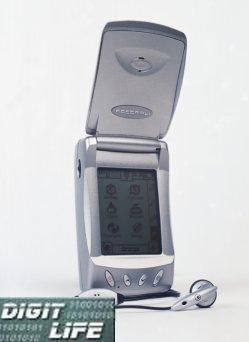 At the end of the year the new Accompli 009 model will appear for CDMA networks with the color display, microkeyboard, font type and voice-activated control; it will cost $400 - $500. The version for GSM-networks, will not be released. 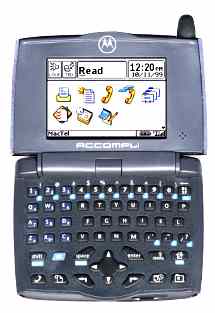 It's indicative that in April Motorola has finally prohibited initial public offer of the Symbian shares. I shall remind that Symbian develops operating systems for mobile telephones and PDAs. The company is owned by Motorola, Psion Plc, Nokia Oyj, Ericsson AB and Matsushita Electric Works Ltd. From all these companies only Psion (28% Symbian shares) has supported the idea of selling the shares "aside". However Psion's initiative has not found any support. But actually, nobody has prohibited anything: the public shares offer has just been transferred. Such step is the evidence of Motorola's desire to consolidate it's grip on the smartphone market and to secure itself against possible problems. Two new products were shown in April. Nextel has announced two telephones that support Java 2 Micro Edition. It is possible to download various Java programs with these telephones via Nextel's site and to write them into telephone memory (384 KBytes for both telephones). J2ME is a flexible solution as it is possible to write any programs, just give the choice. Nextel has presented I85s and I50sx models, which work in Nextel's IDEN network only. By the way, these handsets are made for Nextel by Motorola. There is plenty of functions in these telephones, but still they are not PDAs because of the usual small display and standard 9-key keyboard. Nextel I85s with a built-in digital dictaphone costs $199, and I50sx costs $149. J2ME is perspective, but only with appropriate support. 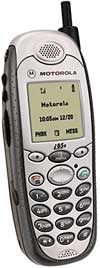 Motorola has also presented new software for mobile telephones - "i-TAP Japanese version". This program makes possible the input in the Japanese language. i-TAP works the same as T9 for English, accessing to the built-in dictionary, it predicts a word after first characters. In the i-TAP Japanese version there is a self-learning system, which is set up under the specific person. It is interesting that into the dictionary contains about a thousand of slang words. And again company Motorola has distinguished itself: USA navy has decided to grant the Polar Trek 2001 North Pole female ski expedition, which has started in middle of April, with two models of Motorola's satellite telephones, intended for operation with the Iridium Satellite LLC. 9500 and 9505 models have been selected from 20 different models. The American fleet has recently signed the two-year contract with Iridium Satellite LLC, and hopes to test the efficiency of the telephones and solar battery chargers, along with the accumulator discharge time in the severe Arctic conditions. It's not a secret that the active time of solar batteries of such mobile devices like telephones is conditioned by lighting. A good charge is usual not a problem at sunny weather outdoors, but it's hard to achieve something acceptable indoors, as the light intensity is 2-3 orders lower. However the high-performance solar batteries with performance factor above 20% were developed in the well-known german Fraunhofer institute. The charger was designed for battery tests which is connected to the mobile telephone and makes a single whole with it. 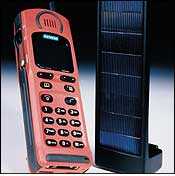 The tests have shown that at clear sunny weather battery power completely suffices to provide an idle operation of the telephone. At artificial lighting or at strong cloudiness the telephone works much longer all the same, than without a charger. Another group of the german scientists has announced in April the development of fibers with photo-electric properties, which can theoretically become a source of energy for mobile telephones, PDA etc. These fibers can be patched into the usual fabric. There are many applications for it to think of: from power supply for mobile devices to energy generation in yachts. The prototypes of such photo-cells were made of ElekTex fabric from ElectroTextiles. However, it is possible to make not only power supply photocells, but also electronic devices, using fabric's conductive properties for production of "soft" microchips. The authorities from ElectroTextiles say that with the help of their fabric talented designers will be able to create devices with the same functionality as the usual "hardware" has. Another advanced enough power supply development. And Mechanical Technology Inc., which lives at the expense of the developments in their direct methanol micro fuel cells (DMFC) technology, plans to apply it into batteries for mobile telephones, PDA, notebooks, and other pocket and portable devices. The company believes that their new fuel batteries can give 10 times more energy than usual Li-Ion batteries for mobile telephones at identical dimensions. The new fuel batteries will be charged instantaneously not by an electricity, but by liquid electrolyte. However, it's still a theory as the development is in the earliest stage. Though who knows, maybe in ten years we shall not charge, but fill batteries. One more alternate source of energy has been offered by Freeplay Energy Europe. There have presented the prototype of the mobile telephone, which needs to be winded up like mechanical watches before talking. Energy is stored in the special device, which substitutes battery in the wind-up telephone. One wind-up approximately suffices for six minutes of talking. The company has presented it's development at the Birmingham exhibition. According to the chief executive of Freeplay Energy Europe - Vivian Bleek, the prototype is efficient and is quite suitable for usage. Though the device seems curious, the company asserts that one of the large mobile telephone manufacturers has shown quite a serious interest to it. The negotiations are at the end already, and in case of success the production will start in the nearest three months. Another undoubtedly interesting development is the miniature web-server, which finds room on a SIM-card of the GSM telephone, which was developed in the Microsoft laboratory in Cambridge. As the sphere of application of the new technology they name organization of Internet payments via the mobile telephone. The development which was named WebCamSIM, is based on the MS Smart Card platform and allows any GSM cellular telephone to transmit data to remote computers through the Internet. The telephone sends data in the SMS format. These SMSes are routed to a special gateway, which transforms data to the format, understandable by computers, connected to the Network. In a similar way data is transmitted from the Internet to the telephone: the gateway converts data contained in IP-packages, to the SMS format and sends them to the telephone. The standard GSM functions are used for data encoding. It is both pro and contra of the system. Pros are technical simplicity and cheapness: it is possible to use already available equipment and infrastructure for new services. A contra is the poor transaction safety in GSM networks, as for the 40-bit keys are used data coding, that is obviously not enough in modern terms. The data is vulnerable at the moment of conversion from SMS to IP and vice versa. Nevertheless, the safety questions can be solved by a banal transition to another operating system, and there are premises for this. Conversay (Conversational Computing Corporation), specializing on speech technologies, has announced the signing of agreement with the Korean PalmPalm Technology corporation about the joint creation of the Linux-platform for Internet devices, which would support the voice applications. In particular, Conversay is going to integrate the technology into the built-in Tynux platform from PalmPalm, created on the basis of Linux operating system. The Tynux platform is designed for smartphones, Internet devices and pocket computers. PalmPalm is going to demonstrate the prototype of such smartphone on the Embedded Systems Conference in San Francisco. According to PalmPalm, it will be the first similar device, based on Linux OS. And in the meantime Samsung has began to produce new "hard panels " - cases for the whole spectrum of devices, where small weight and durability are necessary: mobile telephones, PDAs, notebooks. The new cases will be made of the special composite materials based on plastics, instead of glass. They should weigh 50% less, and their durability should not concede to the modern cases, based on glass. Samsung also has announced that the contract with Palm Inc. about the delivery of 50 thousands of "hard panels" has already been signed. On the Embedded Systems Conference '2001 the Trimble company has announced M-Loc MPM, a tiny GPS-unit operating the company's FirstGPS technology for embedding into mobile products. Due to its dimensions this device can be built into mobile telephones, pagers, PDAs, digital cameras etc. The thing is that M-Loc MTM is not a completely hardware GPS-solution. It uses the memory and the processor of the device, it's built-in, for coordinate, speed and time calculations. And this essentially reduces its size. This unit consumes very small quantity of energy (43 mW in the secondly update mode) and supports different low energy consumption modes (dream, deep dream, etc.). M-Loc MTM does not require additional shielding: it's case is the shield. The dimensions are really scanty - 25X25 mm. 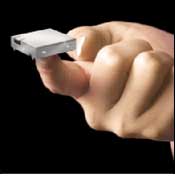 In July this year the new supercompact GPS-unit from Trimble will come into the market. The Siemens company has distinguished itself, having released the MultiMobile smartphone under the control of PocketPC operating system from Microsoft with GPRS support. The Siemens MultiMobile will appear in Europe at first, then the USA version will be released. Besides using MultiMobile as the telephone with email and Internet features, it is possible to run mobile variants of usual Microsoft applications: Word, Excel and Outlook. MultiMobile includes the Media Player, allowing to record and to play back music. A touch LCD screen images up to 65000 colors. PDA is shipped with 32 MBytes of pre-installed flash-memory, and is also equipped with two CompactFlash and MultiMedia Card extension slots. On the photo you can see a result of connection with a Kodak digital camera. 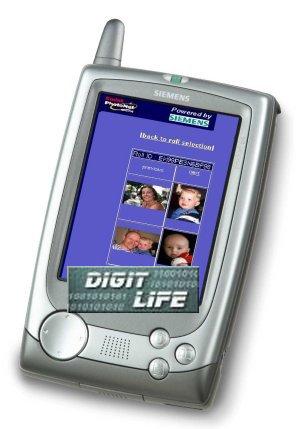 MultiMobile was developed on the basis of Casio Cassiopeia E125 PDA and was named Andromeda during the engineering process. Most likely 'SX45' will be added to the 'MultiMobile' despite the fact that 'SX45' marking had belonged to another concept-model from Siemens until recently. The repetition work of the novelty will start in the beginning of the summer, so that it will appear in shops closer to August. The probable mark-up will make 1200-1400 dollars. 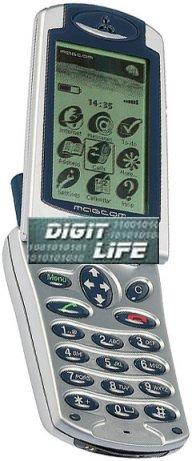 Another interesting smartphone has been presented by the Norwegian Magcom corporation. This device is named after the corporation and is a debut: with it the company wants to enter the market of mobile telephones. The main difference from other smartphones is a triple standard support. The British Pogo Technology company has developed the new device for cordless communications, supporting many features, foreseen in the future 3G networks. There is no necessity to wait began for 3G-networks to use this new device - Pogo users can receive the necessary information already today in GSM-networks. Pogo can be used as the mobile telephone, email messaging device, and as the web-browser (it shows all web-pages, not just the sites specially fitted for mobile devices). Besides, Pogo has a slot for removable multimedia cards capable of storing 64 MBytes of information, that allows to listen to music, to read books, to play etc. The usage of HTML-content in the new device has become possible due to the compression technology (the company has applied for a patent for it), which provides an GSM-network communication with effective speeds exceeding 56 kbps. Pogo repetition work will begin in the middle of 2001. Write a comment below. No registration needed!
|
Platform · Video · Multimedia · Mobile · Other || About us & Privacy policy · Twitter · Facebook Copyright © Byrds Research & Publishing, Ltd., 1997–2011. All rights reserved. |